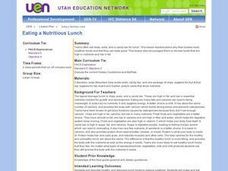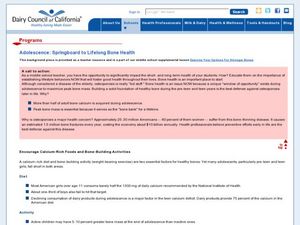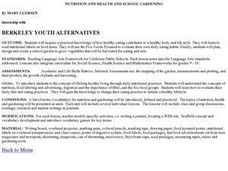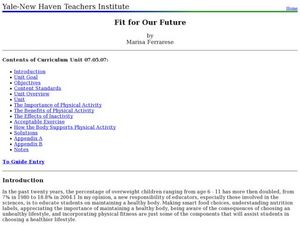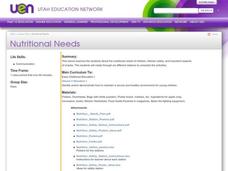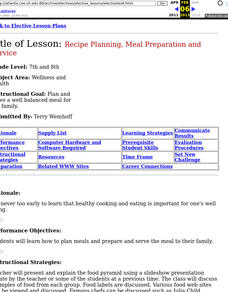Curated OER
Why are People Hungry and Malnourished?
Young scholars read "The Story of Miguel's Tomatoes" to review the steps involved in the food system. In groups, students complete a food system chart. Using the chart as a model, young scholars choose a commonly eaten food and trace it...
Curated OER
Counting on Good Health
First graders engage in fun activities in order to understand the food pyramid and how to make healthy nutritional choices. The lesson is used in order to help students make healthy lifestyle choices.
Curated OER
Eating a Low-fat Nutritious Lunch
Students describe healthy and delicious lunch foods to replace junk foods. They make and eat lunch foods.
Curated OER
Adolescence: Springboard to Lifelong Bone Health
Students discuss bone health. In this health lesson, students talk about foods and activities that can foster strong bones. Students explore ways to defeat obstacles to bone health.
Curated OER
Vegetable Twister
Learners review vegetables and their nutrient values and production. In this vegetable production worksheet, students read information about the nutrients in vegetables and how they are grown. Learners participate in a game of Twister to...
Curated OER
Eating, A Family Affair
Students explain the benefits of eating together as a family. In this adult health lesson, students share their happy mealtime experience with each other. They develop a mealtime goal for their family.
Curated OER
Ocean Pollution
Students study their role in eliminating ocean pollution and helping keep the oceans clean. In this environmental issues lesson, students define pollution and brainstorm examples of ocean pollution. Students define biodegradable and...
Curated OER
Nutrition and Health and School Gardening
Students examine how healthy eating contributes to a healthy body and life style. They read nutritional labels on food items. They use the Five Foods Pyramid to evaluate their own eating habits. They plan, design, and create a school...
Curated OER
You Are What You Eat
Students evaluate their eating habits, focusing on the ways in which one assesses whether or not his or her diet is nutritious. They work in small groups to design a menu for a healthy lunch and write a paragraph justifying their choices.
Curated OER
Health and Growth
Students recognize that living things need food and water. In this health and growth lesson, students identify foods that are better for health and growth. Students sing a song and complete a worksheet. Students understand that they...
Curated OER
Nutrition Track
Students examine the importance of a healthy diet based on the USDA food pyramid. They log their daily food intake in a journal. They create charts to analyze and compare their diets to the USDA recommended allowances.
Curated OER
The Salmon Stream and Vegetation
Students explore the ecosystem and food chain by researching Pacific Salmon. In this fish habitat lesson, students discover the life cycle for salmon, where they spawn and what they eat to survive the harsh elements. Students participate...
Curated OER
Arthropods at Home: Spider, Isopod, or any Arthropod
Second graders observe, discuss, and record the requirements of a healthy environment for both arthropods and people by designing and maintaining an artificial habitat for an arthropod, and considering the requirements for a healthy body...
Curated OER
The Magical Ingredient: Fat
High schoolers explore fats in foods. In this personal health and nutrition lesson, students view a Frontline video segment, examine the role fat plays in their personal diets, and develop plans to eliminate fats and implement exercise...
Curated OER
The Magical Ingredient: FAT
Learners examine how the diet industry is contributing to our frustration over unwanted pounds. They identify the part fat plays in their diets and determine if they live in a food toxic environment.
Curated OER
Fit for Our Future
Learners understand the importance of physical fitness as part of a healthy lifestyle. In this health lesson students create a display and presentation about what they learned.
Curated OER
Nutritional Needs
Students complete work at six stations as they investigate children's nutritional needs, kitchen safety, and snacks. First, they listen to Dr. Seuss', "Green Eggs and Ham" before discussing nutrition and the station activities. At each...
Curated OER
Recipe Planning, Meal Preparation and Service
Students examine how to plan, prepare, and serve a meal. They analyze the food pyramid, select five recipes, plan a dinner menu, create a HyperCard stack of the menu, and prepare the meal for their family.
Curated OER
Planting Seeds Around the World
First graders discuss the book The Lorax and research what living things need. In this environmental instructional activity, 1st graders investigate how humans affect the growth of plants. Students conduct an experiment with sunflowers.
Curated OER
Teaching Lewis and Clark: Tribal Cultures and Homelands
Learners examine the attributes of the tribes that inhabited the Columbia River Basin. In this Lewis and Clark lesson, students participate in a classroom simulation that requires them to participate in a seasonal round, in which they...
Curated OER
Following a Recipe
Students create a cookbook. In this recipe and writing lesson, students brainstorm the skills necessary to follow a recipe, watch a cooking show and write down a recipe used. Students use a word processing program to write a paragraph...
Curated OER
English Settlements in North America, A Royal Charter from the King
Fifth graders develop a colony to be evaluated by the teacher in the role of a "Royal Inspector". In this social studies lesson plan, 5th graders design aspects of a successful society by planning forms of government, politics, and an...
Curated OER
The Bare Necessities
Students distinguish between wants and needs. In this basic needs lesson, students understand that some people do not have the basic necessities and that they can help them. Student suggestions to help are charted. Students are...
Curated OER
Molehill or Mountain
Students explore the concept of waste management. In this environmental stewardship lesson, students consider the trash generated by people per day and discuss what steps they can personally take to reduce waste.




